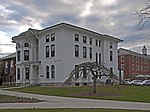Cheshire County, New Hampshire
1769 establishments in New HampshireCheshire County, New HampshireNew Hampshire countiesPopulated places established in 1769Use mdy dates from November 2021

Cheshire County is a county in the southwestern corner of the U.S. state of New Hampshire. As of the 2020 census, the population was 76,458. Its county seat is the city of Keene. Cheshire was one of the five original counties of New Hampshire, and is named for the county of Cheshire in England. It was organized in 1771 at Keene. Sullivan County was created from the northern portion of Cheshire County in 1827. Cheshire County comprises the Keene, NH micropolitan statistical area.
Excerpt from the Wikipedia article Cheshire County, New Hampshire (License: CC BY-SA 3.0, Authors, Images).Cheshire County, New Hampshire
Keene
Geographical coordinates (GPS) Address Nearby Places Show on map
Geographical coordinates (GPS)
| Latitude | Longitude |
|---|---|
| N 42.92 ° | E -72.25 ° |
Address
03435 Keene
New Hampshire, United States
Open on Google Maps










